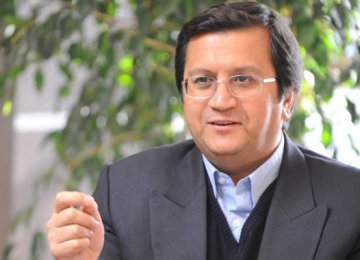In light of failure of commercial banks in recent years to provide adequate degree of company loans on a widespread basis, the Central Bank of Iran urges them to sell their non-banking assets, a move that CBI officials hope will shore up their financial resources. But latest data shows the amount of money the banks may receive is still far less than they need.
A banking official said last week that the banking system’s nonperforming loans are over 870 trillion rials ($32.7 billion), three times more than the amount the commercial banks hold in firm equities.
Abdol-Naser Hemmati, head of the coordination council of state-owned banks said in a television program on Sunday that the central bank has even handed down the names of 570 bank debtors, who totally hold 30 percent of total NPLs, to the judiciary. That could help banks to revive a major part of their money, he added.
“The overdue loans have crippled bank performance, and their effects have been far more adverse than banks’ firm running operations,” Hemmati said.
Commercial banks are financing up to 80 percent of economic activities in Iran, a proportion that underscores their significance in the eyes of ordinary people and authorities. “Banks are the driving force behind any successful economy, when they are allowed to work properly,” he said.
He attributed the present status of the banking system to the wrong policies adopted in the past years and the obligatory loans that were imposed on the banks as a result of such policies, which “excluded them from the process of decision making as main economic institutes.”
The government and CBI are determined to correct the banking system, as part of a greater plan to help the economy exit stagflation – recession coupled with high inflation.
“The government is going to pay its debts to the commercial banks – debts that incurred as the result of wrong decisions of the previous government – to enable the commercial banks to pay their debts to the central bank, and their power for awarding credit facilities become enhanced,” said the official.
Hemmati, who is also the CEO of Bank Melli, defended the banks which have recently been accused of excessively running firms, and said that the job was mostly “imposed on them,” as the former government gave them the ownership of firms in large scales in return for its debts. Some of them cannot even be sold, like sugarcane and related industries of which 80 percent in equity worth 90 trillion rials ($3.3 billion) was transferred to Bank Melli and Bank Saderat. Now the two lenders are unable to sell them.
Bank Melli has returned some of these factories to their owners, said Hemmati, but it still has to control and finance them because they mostly lack the ability to properly handle their labor affairs among other problems.
However, he confirmed that some banks have violated the permissible ceiling for firm ownership, which is going to be stopped, saying that “the CBI has set a 5 year period for commercial banks to sell off their assets.”
Now, both CBI and the commercial banks are determined to solve the problem.
“Only 30 of the Bank Melli’s debtors owe 50 trillion rials to the bank,” said Hemmati, however, the bank is determined to collect its debts soon.
Previously CBI instructed commercial banks to sell off their assets and equities in a course of five years. Since they cannot be sold at once, the government is going to do the process gradually. To this end, “Bank Melli is about to sell 20 trillion rials of its assets and equities by the end of the year.”
Although liquidity has increased in recent year, “an average amount of 15 percent of the liquidity was absorbed by banks as deposits in the first five month since the beginning of this year.”
“CBI has planned to pay 2800 trillion rials ($105 billion) of credit facilities. We have already financed 50 percent of this amount and the other half should be absorbed. However, this is in addition to the foreign currency credits of the banks, which will be financed from China or the National Development Fund of Iran,” said Hemmati.
Regarding interest rates, Hemmati asserted that so far 95 percent of banks and financial institutions, have started to pay 22 percent interest on deposits, as specified by the CBI. Still there are some other institutes that violate the ceiling and pay higher interest rates. Hemmati said that “the rates that they promise cannot be provided via financing manufacturing activities,” hoping that the institutes will also get in line with CBI regulations, soon.
The government has adopted a policy to lower inflation to less than 20 percent by the end of the year, Hemmati said, “So it is natural that the interest rates are reviewed in line with that.”
widespread basis, the Central Bank of Iran urges them to sell their non-banking assets, a move that CBI officials hope will shore up their financial resources. But latest data shows the amount of money the banks may receive is still far less than they need.
A banking official said last week that the banking system’s nonperforming loans are over 870 trillion rials ($32.7 billion), three times more than the amount the commercial banks hold in firm equities.
Abdol-Naser Hemmati, head of the coordination council of state-owned banks said in a television program on Sunday that the central bank has even handed down the names of 570 bank debtors, who totally hold 30 percent of total NPLs, to the judiciary. That could help banks to revive a major part of their money, he added.
“The overdue loans have crippled bank performance, and their effects have been far more adverse than banks’ firm running operations,” Hemmati said.
Commercial banks are financing up to 80 percent of economic activities in Iran, a proportion that underscores their significance in the eyes of ordinary people and authorities. “Banks are the driving force behind any successful economy, when they are allowed to work properly,” he said.
He attributed the present status of the banking system to the wrong policies adopted in the past years and the obligatory loans that were imposed on the banks as a result of such policies, which “excluded them from the process of decision making as main economic institutes.”
The government and CBI are determined to correct the banking system, as part of a greater plan to help the economy exit stagflation – recession coupled with high inflation.
“The government is going to pay its debts to the commercial banks – debts that incurred as the result of wrong decisions of the previous government – to enable the commercial banks to pay their debts to the central bank, and their power for awarding credit facilities become enhanced,” said the official.
Hemmati, who is also the CEO of Bank Melli, defended the banks which have recently been accused of excessively running firms, and said that the job was mostly “imposed on them,” as the former government gave them the ownership of firms in large scales in return for its debts. Some of them cannot even be sold, like sugarcane and related industries of which 80 percent in equity worth 90 trillion rials ($3.3 billion) was transferred to Bank Melli and Bank Saderat. Now the two lenders are unable to sell them.
Bank Melli has returned some of these factories to their owners, said Hemmati, but it still has to control and finance them because they mostly lack the ability to properly handle their labor affairs among other problems.
However, he confirmed that some banks have violated the permissible ceiling for firm ownership, which is going to be stopped, saying that “the CBI has set a 5 year period for commercial banks to sell off their assets.”
Now, both CBI and the commercial banks are determined to solve the problem.
“Only 30 of the Bank Melli’s debtors owe 50 trillion rials to the bank,” said Hemmati, however, the bank is determined to collect its debts soon.
Previously CBI instructed commercial banks to sell off their assets and equities in a course of five years. Since they cannot be sold at once, the government is going to do the process gradually. To this end, “Bank Melli is about to sell 20 trillion rials of its assets and equities by the end of the year.”
Although liquidity has increased in recent year, “an average amount of 15 percent of the liquidity was absorbed by banks as deposits in the first five month since the beginning of this year.”
“CBI has planned to pay 2800 trillion rials ($105 billion) of credit facilities. We have already financed 50 percent of this amount and the other half should be absorbed. However, this is in addition to the foreign currency credits of the banks, which will be financed from China or the National Development Fund of Iran,” said Hemmati.
Regarding interest rates, Hemmati asserted that so far 95 percent of banks and financial institutions, have started to pay 22 percent interest on deposits, as specified by the CBI. Still there are some other institutes that violate the ceiling and pay higher interest rates. Hemmati said that “the rates that they promise cannot be provided via financing manufacturing activities,” hoping that the institutes will also get in line with CBI regulations, soon.
The government has adopted a policy to lower inflation to less than 20 percent by the end of the year, Hemmati said, “So it is natural that the interest rates are reviewed in line with that.”





